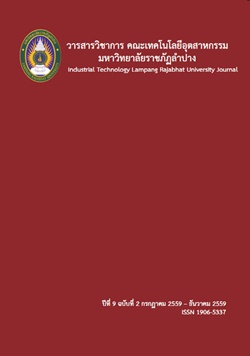13. ผลของลิเทียมคาร์บอเนตและเศษแก้วต่อการลดอุณหภูมิสุกตัวของเนื้อดินสำหรับผลิตกระเบื้องปูพื้น
Keywords:
เศษแก้วบด, ลิเทียมคาร์บอเนต, Cullet, Lithium carbonateAbstract
การวิจัยนี้มีวัตถุประสงค์เพื่อเปรียบเทียบสมบัติทางกายภาพของเนื้อกระเบื้องปูพื้นที่ใช้ ดินขาวผสมกับควอตซ์และแร่ฟันม้า หลังเผาที่อุณหภูมิ 1100 และ 1150 องศาเซลเซียส เทียบกับเนื้อกระเบื้องปูพื้นที่ใช้เศษแก้วบดแทนแร่ฟันม้า และศึกษาผลการใช้ลิเทียมคาร์บอเนตร่วมกับเศษแก้วบดที่ใช้แทนแร่ฟันม้าต่อการลดอุณหภูมิสุกตัวของเนื้อดินสำหรับผลิตกระเบื้องปูพื้น โดยการนำดินขาว จังหวัดระนอง ผสมกับแร่ฟันม้า ควอตซ์ และใช้เศษแก้วบดในเนื้อดินแทนแร่ฟันม้าที่ร้อยละ 0 และ 100 โดยเติมลิเทียมคาร์บอเนตในส่วนผสมของเนื้อดิน ร้อยละ 0 0.5 และ 1.0 ตามลำดับ จำนวน 6 สูตร เผาที่อุณหภูมิ 1100 และ 1150 องศาเซลเซียส แล้วนำมาหาค่าการหดตัว ทดสอบสมบัติด้านการดูดซึมน้ำ และวัดค่าสี (CIELab) จากการศึกษาเปรียบเทียบสมบัติทางกายภาพของเนื้อดินระหว่างใช้แร่ฟันม้าเป็นส่วนผสมกับใช้เศษแก้วบดแทนแร่ฟันม้า พบว่า เนื้อดินที่ใช้ แร่ฟันม้าเป็นส่วนผสมหลังเผาที่อุณหภูมิ 1100 องศาเซลเซียส มีค่าการหดตัว ร้อยละ 0.80 - 1.41 น้อยกว่าเนื้อดินที่ใช้เศษแก้วบดแทนแร่ฟันม้าที่มีค่าการหดตัว ร้อยละ 5.19 - 5.84 และมีค่าการดูดซึมน้ำ ร้อยละ 25.14 - 26.62 โดยน้ำหนัก มากกว่าเนื้อดินที่ใช้เศษแก้วบดแทนแร่ฟันม้าที่มีค่าการดูดซึมน้ำ ร้อยละ 13.92 - 16.12 โดยน้ำหนัก และพบว่า เนื้อดินที่ใช้แร่ฟันม้าเป็นส่วนผสมหลังเผาที่อุณหภูมิ 1150 องศาเซลเซียส มีค่าการหดตัว ร้อยละ 10.85 - 11.20 มากกว่าเนื้อดินที่ใช้เศษแก้วบดแทนแร่ฟันม้าที่มีค่าการหดตัว ร้อยละ 8.35 - 9.01 มีค่าการดูดซึมน้ำ ร้อยละ 0.16 - 0.30 โดยน้ำหนัก ใกล้เคียงเนื้อดินที่ใช้เศษแก้วบดแทนแร่ฟันม้าที่มีค่าการดูดซึมน้ำ ร้อยละ 0.15 - 0.30 โดยน้ำหนัก และค่าความสว่าง (L*) ร้อยละ 83.43 - 84.32 มากกว่าเนื้อดินที่ใช้เศษแก้วบดแทนแร่ฟันม้าที่มีค่าความสว่าง (L*) ร้อยละ 76.04 - 76.48 และจากการศึกษาพบว่า การใช้ลิเทียมคาร์บอเนตร่วมกับ เศษแก้วบดที่ใช้แทนแร่ฟันม้า เป็นส่วนผสมของเนื้อดินมีผลต่อการลดอุณหภูมิสุกตัวของเนื้อดิน และมีแนวโน้มสามารถนำไปพัฒนาส่วนผสมของเนื้อดินสำหรับผลิตกระเบื้องปูพื้นดูดซึมน้ำต่ำไม่เกินร้อยละ 0.5 ให้สามารถใช้อุณหภูมิเผาไม่เกิน 1150 องศาเซลเซียสได้
The Effect of Cullet and Lithium Carbonate on Reducing Sintering Temperature of Ceramic Floor Tiles
This study compared the physical properties of ceramic floor tiles made from kaolin and quartz with those made from glass cullet and feldspar prepared at sintering temperatures of 1100°C and 1150°C. In addition, the effects of using lithium carbonate and glass cullet instead of feldspar to reduce the sintering temperature of ceramic floor tiles were studied. The base body was prepared from Ranong kaolin, feldspar and quartz. Feldspar was replaced by glass cullet at proportions of 0% and 100%. Lithium carbonate was used as an additive at proportions of 0%, 0.5% and 1.0%. A total of six formula samples were prepared and fired at 1100°C and 1150°C. Shrinkage, water absorption, and color (CIELab) were measured in the fired samples. The results showed that at 1100°C, the shrinkage of feldspar samples (0.80-1.41%) was less than that of glass cullet samples (5.19-5.84%). The water absorption of feldspar tiles (5.14-26.62%) was more than that of glass cullet tiles (13.92-16.12%). At 1150°C, the shrinkage of feldspar tiles (10.85-11.20%) was more than that of glass cullet tiles (8.35-9.01%). The water absorption of feldspar-added samples (0.16-0.30%) was comparable to that of glass cullet tiles (0.15-0.30%). Moreover, the brightness (L*) of feldspar tiles (83.43-84.32%) was greater than that of glass cullet tiles (76.04-76.48%). It was also found that the sintering temperature of the tiles could be further reduced by adding lithium carbonate to the glass cullet. Glass cullet together with lithium carbonate were therefore shown to be promising raw materials if used to develop low water-absorption ceramic floor tiles, at a proportion of not more than 0.5% and at a sintering temperature of not more than 1150°C.






